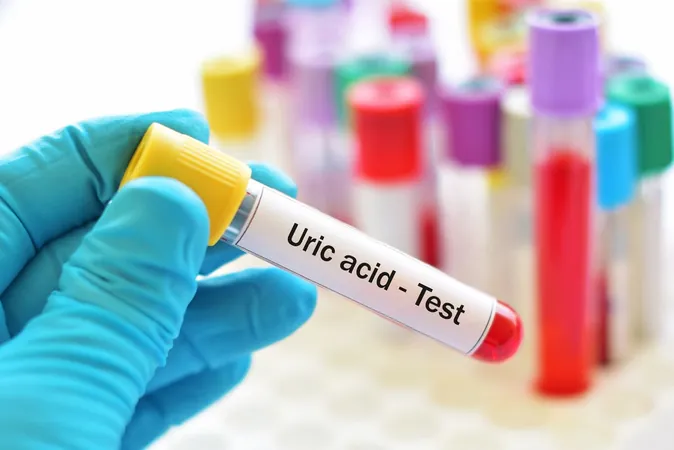
Groundbreaking Study Links High Uric Acid Levels to Pulmonary Arterial Hypertension: What You Need to Know!
2025-01-03
Author: Rajesh
Introduction
A recent study has unveiled a potentially pivotal link between hyperuricemia, a condition characterized by elevated uric acid (UA) levels in the blood, and pulmonary arterial hypertension (PAH), suggesting that UA may be a key target for treatment strategies aimed at combating this serious disease. The findings, published in the journal Heart & Lung, point to underlying biochemical pathways that may contribute to the development of PAH.
Researchers and Methods
Dr. Jiang Li and researchers from the Second Xiangya Hospital at China’s Central South University conducted an extensive analysis, emphasizing that while the full etiology of PAH remains shrouded in mystery, genetic factors play a significant role. Their research builds upon previous studies linking genetic predisposition to PAH, as well as the established connection between high UA levels and various cardiovascular diseases.
Key Findings
In a particularly striking revelation, the study highlights that patients with elevated UA levels have an increased incidence of atrial fibrillation, a condition that affects the heart's rhythm and can lead to severe complications. The investigators pointed out that while UA has been previously implicated in endothelial dysfunction and possibly even in the development of PAH, it was critical to ascertain whether hyperuricemia directly causes this condition.
Methodology Explanation
To explore this relationship, the team employed a method known as Mendelian randomization, utilizing large publicly available genetic databases. This approach allowed them to isolate the genetic factors influencing UA levels and establish a causal relationship with PAH. Their findings revealed that increased UA is not merely correlated with PAH; it may indeed play a direct role in its pathogenesis.
Mechanisms Proposed
Dr. Li's team proposed three potential mechanisms by which elevated UA could trigger PAH: causing endothelial dysfunction, stimulating the proliferation of smooth muscle cells through growth factor release and inflammatory responses, or enhancing the expression of angiotensin II, leading to increased pulmonary arterial pressure and oxidative stress.
Limitations of the Study
Despite these promising findings, researchers acknowledged limitations, including their reliance on European cohort data, which may not be representative of other ethnic groups. Furthermore, variations due to age, gender, and environmental factors were not accounted for, which could influence UA levels and PAH risk.
Significance of Findings
Given that the five-year survival rate for PAH remains alarmingly low—below 60%—the implications of this research are profound. The team emphasizes the urgent need for early screening in individuals with hyperuricemia and suggests that managing UA levels could lead to significant advancements in the treatment of PAH.
Future Directions
Future studies are urged to delve deeper into the mechanisms by which elevated UA exacerbates endothelial dysfunction and vascular remodeling, with the hope of paving the way for novel treatment methods that could dramatically alter PAH management.
Conclusion
This groundbreaking research could reshape our understanding of PAH and signal a critical shift in how we approach screening and treatment strategies for this life-threatening condition. Stay tuned for further updates as this story develops!

 Brasil (PT)
Brasil (PT)
 Canada (EN)
Canada (EN)
 Chile (ES)
Chile (ES)
 Česko (CS)
Česko (CS)
 대한민국 (KO)
대한민국 (KO)
 España (ES)
España (ES)
 France (FR)
France (FR)
 Hong Kong (EN)
Hong Kong (EN)
 Italia (IT)
Italia (IT)
 日本 (JA)
日本 (JA)
 Magyarország (HU)
Magyarország (HU)
 Norge (NO)
Norge (NO)
 Polska (PL)
Polska (PL)
 Schweiz (DE)
Schweiz (DE)
 Singapore (EN)
Singapore (EN)
 Sverige (SV)
Sverige (SV)
 Suomi (FI)
Suomi (FI)
 Türkiye (TR)
Türkiye (TR)
 الإمارات العربية المتحدة (AR)
الإمارات العربية المتحدة (AR)